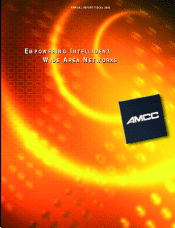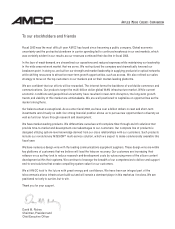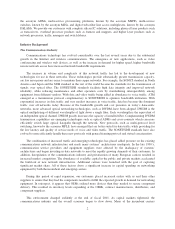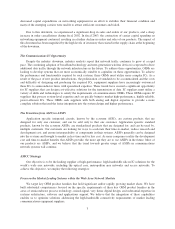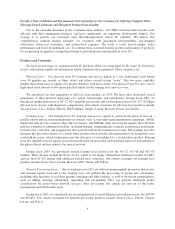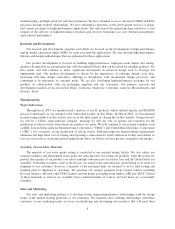3Ware 2003 Annual Report Download - page 7
Download and view the complete annual report
Please find page 7 of the 2003 3Ware annual report below. You can navigate through the pages in the report by either clicking on the pages listed below, or by using the keyword search tool below to find specific information within the annual report.the acronym ADMs, multi-service provisioning platforms, known by the acronym MSPPs, multi-service
switches, known by the acronym MSSs, and digital subscriber line access multiplexers, known by the acronym
DSLAMs. We provide our customers with complete silicon IC solutions, including physical layer products such
as transceivers, overhead processor products such as framers and mappers, and higher layer products such as
network processors, traffic managers and switch fabrics.
Industry Background
The Communications Industry
Communications technology has evolved considerably over the last several years due to the substantial
growth in the Internet and wireless communications. The emergence of new applications, such as video
conferencing and wireless web devices, as well as the increase in demand for higher speed, higher bandwidth
remote network access have increased network bandwidth requirements.
The increase in volume and complexity of this network traffic has led to the development of new
technologies for use in these networks. These technologies provide substantially greater transmission capacity,
are less error prone and are easier to maintain than copper networks. For example, the SONET standard in North
America and Japan and the SDH standard in the rest of the world became the standards for the transmission of
signals over optical fiber. The SONET/SDH standards facilitate high data integrity and improved network
reliability, while reducing maintenance and other operation costs by standardizing interoperability among
equipment from different vendors. With data and video traffic being added in abundance to voice traffic, ATM
emerged as a transmission protocol complementary to SONET/SDH to optimize bandwidth utilization. With
exponential increases in data traffic and very modest increases in voice traffic, data has become the dominant
traffic over all networks today. Because of the bandwidth growth and cost pressures in today’s datacentric
networks, more advanced optical networking technologies, such as DWDM, have been adopted. DWDM is the
optical multiplexing of different wavelengths of light down a single fiber. Each wavelength is the equivalent of
an independent optical channel. DWDM greatly increases the capacity of installed fiber. Complementing DWDM
transmission capabilities are emerging technologies such as optical ADMs and cross-connects which can more
efficiently switch large optical datapaths through the network. New protocols, such as multi-protocol level
switching, known by the acronym MPLS, have emerged that are better suited for data traffic while providing for
the low latency and quality of service needs of voice and video traffic. The SONET/SDH standards have also
evolved to more efficiently handle these new protocols with general framing protocol and virtual concatenation.
The combination of increased traffic and emerging technologies has placed added pressure on the existing
communications network infrastructure and made many systems’ architectures inadequate. In the late 1990’s,
communication service providers and equipment suppliers were affected by the inadequacy of systems’
architectures and began investing in data networks to meet the rapidly growing demands of their customers. In
addition, deregulation of the communications industry and privatization of many European carriers resulted in
increased market competition. The abundance of available capital in the public and private markets accelerated
the build-out of new network infrastructure. Additional carriers were launched with the goal of capturing
significant market share. All of these factors drove a significant increase in capital spending on networking
equipment by both the incumbent and emerging carriers.
During this period of rapid expansion, our customers placed increased orders with us and their other
suppliers to ensure that they had the components needed to fulfill the expected growth in demand for networking
equipment. In retrospect, it appears that OEMs ordered more devices than they needed to secure component
delivery. This resulted in inventory levels expanding at the OEMs, contract manufacturers, distributors, and
component suppliers.
This environment changed suddenly at the end of fiscal 2001. As capital markets tightened, the
communications industry and the overall economy began to slow down. Many of the incumbent carriers
2

